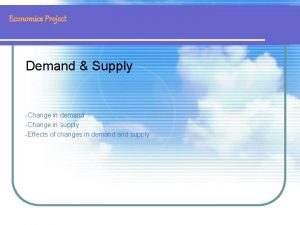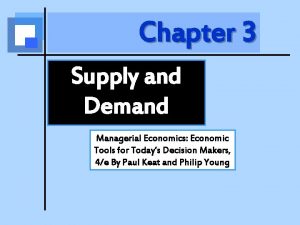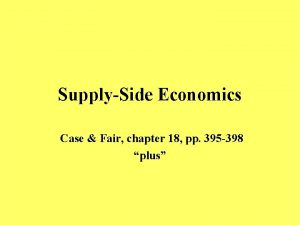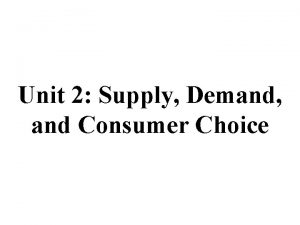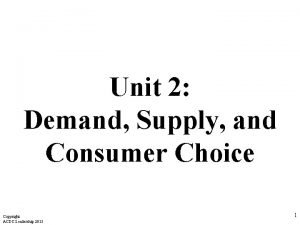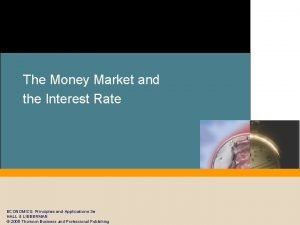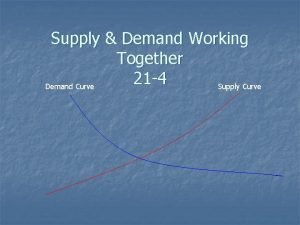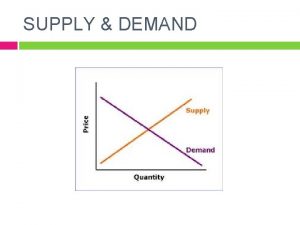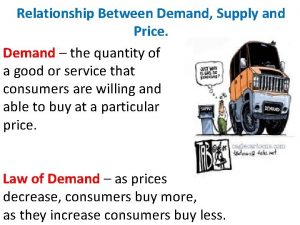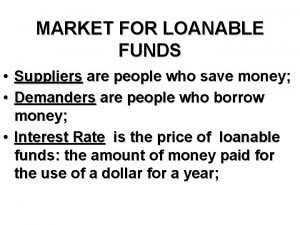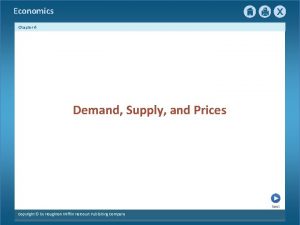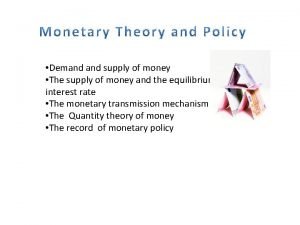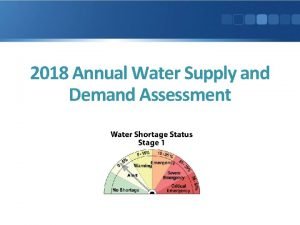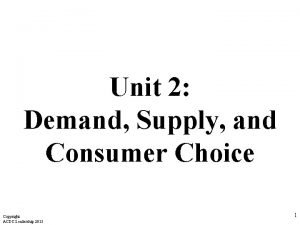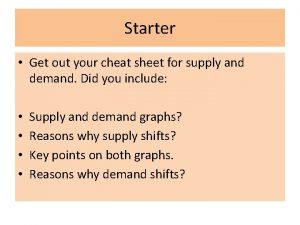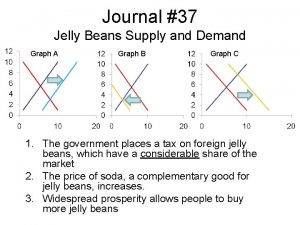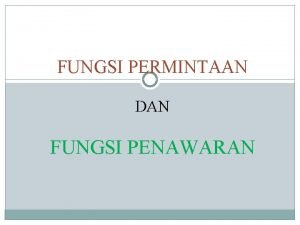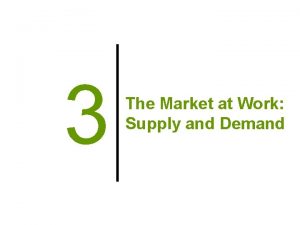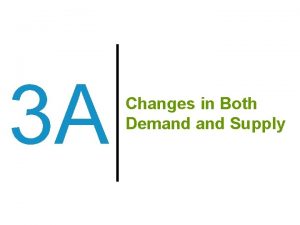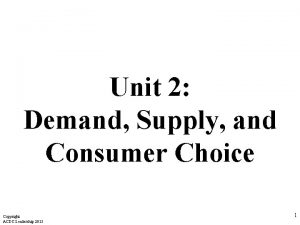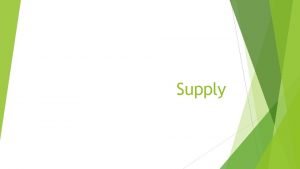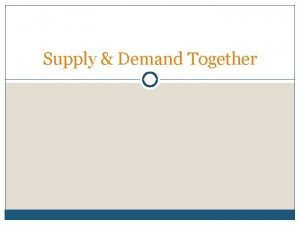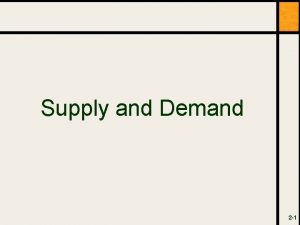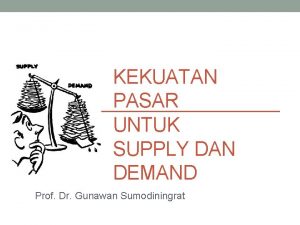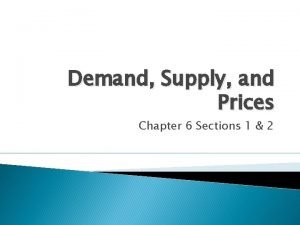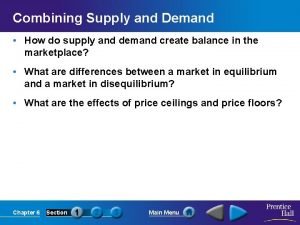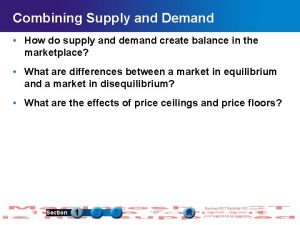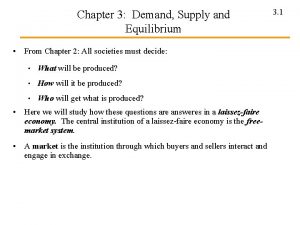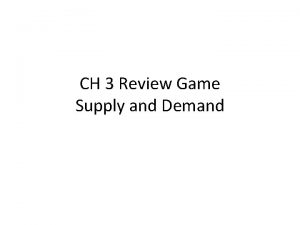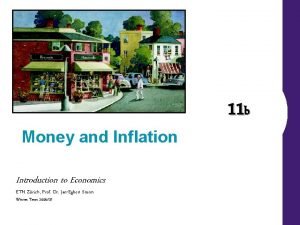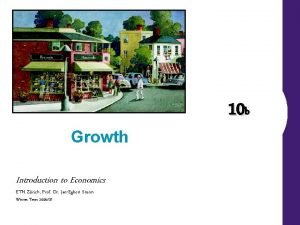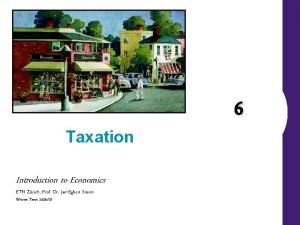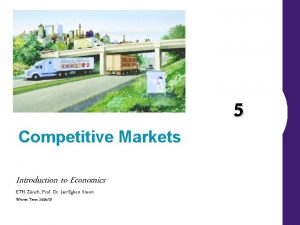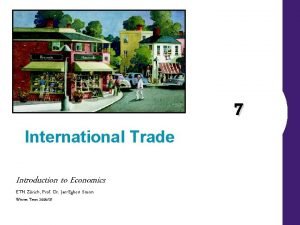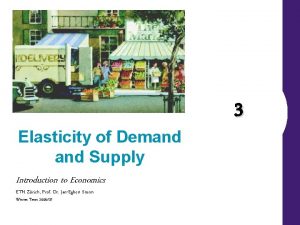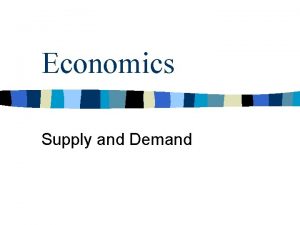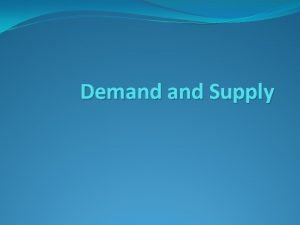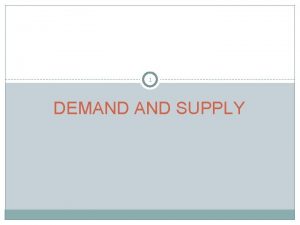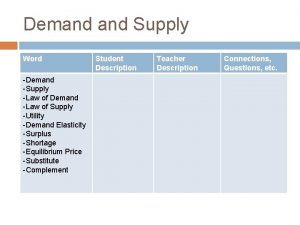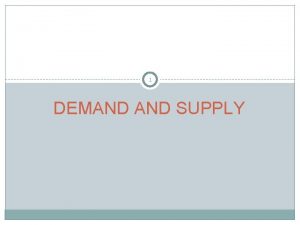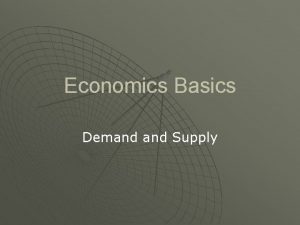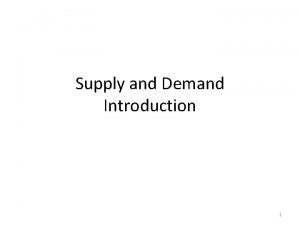Supply and Demand Introduction to Economics ETH Zrich
























































- Slides: 56

Supply and Demand Introduction to Economics ETH Zürich, Prof. Dr. Jan-Egbert Sturm Winter Term 2006/07 2

General Information • Exam dates: • exam period: 19/02/2007 – 16/03/2007 • exact date: will be announced in early January • Type of exam: • 2 hour written exam Konjunkturforschungsstelle Swiss Institute for Business Cycle Research KOF

General Information 24. 10. Introduction; Transformation Curve, Opportunity Cost Mankiw ch. 1, 2 31. 10. Markets: Demand Supply Ch. 4 7. 11. Elasticities Ch. 5 14. 11. Costs, Production Function Ch. 13 21. 11. Markets with perfect competiton Ch. 7, 14 28. 11. Taxation Ch. 8 5. 12. International Trade Ch. 9 12. Imperfect competition: Monopoly, and Oligoploy Ch. 15, 16 19. 12. Public Goods, Externalities Ch. 10, 11 9. 1. National Accounting, Gross Domestic Product, Growth Ch. 23, 25 16. 1. Money and Inflation Ch. 24, 29, 30 23. 1. Business Cycles Ch. 33, 34 30. 1. Open Economy Macro Ch. 31 Konjunkturforschungsstelle Swiss Institute for Business Cycle Research KOF

Supply and Demand • Supply and demand are the two words that economists use most often. • Supply and demand are the forces that make market economies work. • Modern microeconomics is about supply, demand, and market equilibrium. Konjunkturforschungsstelle Swiss Institute for Business Cycle Research KOF

MARKETS AND COMPETITION • A market is a group of buyers and sellers of a particular good or service. • The terms supply and demand refer to the behavior of people. . . as they interact with one another in markets. Konjunkturforschungsstelle Swiss Institute for Business Cycle Research KOF

MARKETS AND COMPETITION • Buyers determine demand. • Sellers determine supply. Konjunkturforschungsstelle Swiss Institute for Business Cycle Research KOF

Competitive Markets • A competitive market is a market in which there are many buyers and sellers so that each has a negligible impact on the market price. Konjunkturforschungsstelle Swiss Institute for Business Cycle Research KOF

Competition: Perfect and Otherwise • Perfect Competition • Products are the same • Numerous buyers and sellers so that each has no influence over price • Buyers and Sellers are price takers • Monopoly • One seller, and seller controls price Konjunkturforschungsstelle Swiss Institute for Business Cycle Research KOF

Competition: Perfect and Otherwise • Oligopoly • Few sellers • Not always aggressive competition • Monopolistic Competition • Many sellers • Slightly differentiated products • Each seller may set price for its own product Konjunkturforschungsstelle Swiss Institute for Business Cycle Research KOF

DEMAND • Quantity demanded is the amount of a good that buyers are willing and able to purchase. • Law of Demand • The law of demand states that, other things equal, the quantity demanded of a good falls when the price of the good rises. Konjunkturforschungsstelle Swiss Institute for Business Cycle Research KOF

The Demand Curve: The Relationship between Price and Quantity Demanded • Demand Schedule • The demand schedule is a table that shows the relationship between the price of the good and the quantity demanded. Konjunkturforschungsstelle Swiss Institute for Business Cycle Research KOF

Catherine’s Demand Schedule Konjunkturforschungsstelle Swiss Institute for Business Cycle Research KOF

The Demand Curve: The Relationship between Price and Quantity Demanded • Demand Curve • The demand curve is a graph of the relationship between the price of a good and the quantity demanded. Konjunkturforschungsstelle Swiss Institute for Business Cycle Research KOF

Figure 1 Catherine’s Demand Schedule and Demand Curve Price of Ice-Cream Cone $3. 00 2. 50 1. A decrease in price. . . 2. 00 1. 50 1. 00 0. 50 0 1 2 3 4 5 6 7 8 9 10 11 12 Quantity of Ice-Cream Cones 2. . increases quantity of cones demanded. Copyright © 2004 South-Western

Market Demand versus Individual Demand • Market demand refers to the sum of all individual demands for a particular good or service. • Graphically, individual demand curves are summed horizontally to obtain the market demand curve. Konjunkturforschungsstelle Swiss Institute for Business Cycle Research KOF

Shifts in the Demand Curve • Change in Quantity Demanded • Movement along the demand curve. • Caused by a change in the price of the product. Konjunkturforschungsstelle Swiss Institute for Business Cycle Research KOF

Changes in Quantity Demanded Price of Ice. Cream Cones B $2. 00 A tax that raises the price of ice-cream cones results in a movement along the demand curve. A 1. 00 D 0 Konjunkturforschungsstelle Swiss Institute for Business Cycle Research KOF 4 8 Quantity of Ice-Cream Cones

Shifts in the Demand Curve • • • Konjunkturforschungsstelle Swiss Institute for Business Cycle Research Consumer income Prices of related goods Tastes Expectations Number of buyers KOF

Shifts in the Demand Curve • Change in Demand • A shift in the demand curve, either to the left or right. • Caused by any change that alters the quantity demanded at every price. Konjunkturforschungsstelle Swiss Institute for Business Cycle Research KOF

Figure 3 Shifts in the Demand Curve Price of Ice-Cream Cone Increase in demand Demand curve, D 3 0 Demand curve, D 1 Demand curve, D 2 Quantity of Ice-Cream Cones Copyright© 2003 Southwestern/Thomson Learning

Shifts in the Demand Curve • Consumer Income • As income increases the demand for a normal good will increase. • As income increases the demand for an inferior good will decrease. Konjunkturforschungsstelle Swiss Institute for Business Cycle Research KOF

Consumer Income Normal Good Price of Ice. Cream Cone $3. 00 An increase in income. . . 2. 50 Increase in demand 2. 00 1. 50 1. 00 0. 50 D 1 Konjunkturforschungsstelle Swiss Institute for Business Cycle Research 0 1 KOF 2 3 4 5 6 7 8 9 10 11 12 D 2 Quantity of Ice-Cream Cones

Consumer Income Inferior Good Price of Ice. Cream Cone $3. 00 2. 50 An increase in income. . . 2. 00 Decrease in demand 1. 50 1. 00 0. 50 D 2 Konjunkturforschungsstelle Swiss Institute for Business Cycle Research KOF 0 1 D 1 2 3 4 5 6 7 8 9 10 11 12 Quantity of Ice-Cream Cones

Shifts in the Demand Curve • Prices of Related Goods • When a fall in the price of one good reduces the demand for another good, the two goods are called substitutes. • When a fall in the price of one good increases the demand for another good, the two goods are called complements. Konjunkturforschungsstelle Swiss Institute for Business Cycle Research KOF

Table 1 Variables That Influence Buyers Copyright© 2004 South-Western

SUPPLY • Quantity supplied is the amount of a good that sellers are willing and able to sell. • Law of Supply • The law of supply states that, other things equal, the quantity supplied of a good rises when the price of the good rises. Konjunkturforschungsstelle Swiss Institute for Business Cycle Research KOF

The Supply Curve: The Relationship between Price and Quantity Supplied • Supply Schedule • The supply schedule is a table that shows the relationship between the price of the good and the quantity supplied. Konjunkturforschungsstelle Swiss Institute for Business Cycle Research KOF

Ben’s Supply Schedule Supplied Konjunkturforschungsstelle Swiss Institute for Business Cycle Research KOF

The Supply Curve: The Relationship between Price and Quantity Supplied • Supply Curve • The supply curve is the graph of the relationship between the price of a good and the quantity supplied. Konjunkturforschungsstelle Swiss Institute for Business Cycle Research KOF

Figure 5 Ben’s Supply Schedule and Supply Curve Price of Ice-Cream Cone $3. 00 1. An increase in price. . . 2. 50 2. 00 1. 50 1. 00 0. 50 0 1 2 3 4 5 6 7 8 9 10 11 12 Quantity of Ice-Cream Cones 2. . increases quantity of cones supplied. Copyright© 2003 Southwestern/Thomson Learning

Market Supply versus Individual Supply • Market supply refers to the sum of all individual supplies for all sellers of a particular good or service. • Graphically, individual supply curves are summed horizontally to obtain the market supply curve. Konjunkturforschungsstelle Swiss Institute for Business Cycle Research KOF

Shifts in the Supply Curve • • Input prices Technology Expectations Number of sellers Konjunkturforschungsstelle Swiss Institute for Business Cycle Research KOF

Shifts in the Supply Curve • Change in Quantity Supplied • Movement along the supply curve. • Caused by a change in anything that alters the quantity supplied at each price. Konjunkturforschungsstelle Swiss Institute for Business Cycle Research KOF

Change in Quantity Supplied Price of Ice. Cream Cone S C $3. 00 A 1. 00 Konjunkturforschungsstelle Swiss Institute for Business Cycle Research A rise in the price of ice cream cones results in a movement along the supply curve. 0 KOF 1 5 Quantity of Ice-Cream Cones

Shifts in the Supply Curve • Change in Supply • A shift in the supply curve, either to the left or right. • Caused by a change in a determinant other than price. Konjunkturforschungsstelle Swiss Institute for Business Cycle Research KOF

Figure 7 Shifts in the Supply Curve Price of Ice-Cream Cone Supply curve, S 3 Decrease in supply Supply curve, S 1 Supply curve, S 2 Increase in supply 0 Quantity of Ice-Cream Cones Copyright© 2003 Southwestern/Thomson Learning

Table 2 Variables That Influence Sellers Copyright© 2004 South-Western

SUPPLY AND DEMAND TOGETHER • Equilibrium refers to a situation in which the price has reached the level where quantity supplied equals quantity demanded. Konjunkturforschungsstelle Swiss Institute for Business Cycle Research KOF

SUPPLY AND DEMAND TOGETHER • Equilibrium Price • The price that balances quantity supplied and quantity demanded. • On a graph, it is the price at which the supply and demand curves intersect. • Equilibrium Quantity • The quantity supplied and the quantity demanded at the equilibrium price. • On a graph it is the quantity at which the supply and demand curves intersect. Konjunkturforschungsstelle Swiss Institute for Business Cycle Research KOF

SUPPLY AND DEMAND TOGETHER Demand Schedule Supply Schedule At $2. 00, the quantity demanded is equal to the quantity supplied! Konjunkturforschungsstelle Swiss Institute for Business Cycle Research KOF

Figure 8 The Equilibrium of Supply and Demand Price of Ice-Cream Cone Supply Equilibrium price $2. 00 Equilibrium quantity 0 1 2 3 4 5 6 7 8 Demand 9 10 11 12 13 Quantity of Ice-Cream Cones Copyright© 2003 Southwestern/Thomson Learning

Figure 9 Markets Not in Equilibrium (a) Excess Supply Price of Ice-Cream Cone Supply Surplus $2. 50 2. 00 Demand 0 4 Quantity demanded 7 10 Quantity supplied Quantity of Ice-Cream Cones Copyright© 2003 Southwestern/Thomson Learning

Equilibrium • Surplus • When price > equilibrium price, then quantity supplied > quantity demanded. • There is excess supply or a surplus. • Suppliers will lower the price to increase sales, thereby moving toward equilibrium. Konjunkturforschungsstelle Swiss Institute for Business Cycle Research KOF

Equilibrium • Shortage • When price < equilibrium price, then quantity demanded > the quantity supplied. • There is excess demand or a shortage. • Suppliers will raise the price due to too many buyers chasing too few goods, thereby moving toward equilibrium. Konjunkturforschungsstelle Swiss Institute for Business Cycle Research KOF

Figure 9 Markets Not in Equilibrium (b) Excess Demand Price of Ice-Cream Cone Supply $2. 00 1. 50 Shortage Demand 0 4 Quantity supplied 7 10 Quantity of Quantity Ice-Cream demanded Cones Copyright© 2003 Southwestern/Thomson Learning

Equilibrium • Law of supply and demand • The claim that the price of any good adjusts to bring the quantity supplied and the quantity demanded for that good into balance. Konjunkturforschungsstelle Swiss Institute for Business Cycle Research KOF

Three Steps to Analyzing Changes in Equilibrium • Decide whether the event shifts the supply or demand curve (or both). • Decide whether the curve(s) shift(s) to the left or to the right. • Use the supply-and-demand diagram to see how the shift affects equilibrium price and quantity. Konjunkturforschungsstelle Swiss Institute for Business Cycle Research KOF

Figure 10 How an Increase in Demand Affects the Equilibrium Price of Ice-Cream Cone 1. Hot weather increases the demand for ice cream. . . Supply New equilibrium $2. 50 2. 00 2. . resulting in a higher price. . . Initial equilibrium D D 0 7 3. . and a higher quantity sold. 10 Quantity of Ice-Cream Cones Copyright© 2003 Southwestern/Thomson Learning

Three Steps to Analyzing Changes in Equilibrium • Shifts in Curves versus Movements along Curves • A shift in the supply curve is called a change in supply. • A movement along a fixed supply curve is called a change in quantity supplied. • A shift in the demand curve is called a change in demand. • A movement along a fixed demand curve is called a change in quantity demanded. Konjunkturforschungsstelle Swiss Institute for Business Cycle Research KOF

Figure 11 How a Decrease in Supply Affects the Equilibrium Price of Ice-Cream Cone S 2 1. An increase in the price of sugar reduces the supply of ice cream. . . S 1 New equilibrium $2. 50 Initial equilibrium 2. 00 2. . resulting in a higher price of ice cream. . . Demand 0 4 7 3. . and a lower quantity sold. Quantity of Ice-Cream Cones Copyright© 2003 Southwestern/Thomson Learning

Table 4 What Happens to Price and Quantity When Supply or Demand Shifts? Copyright© 2004 South-Western

Summary • Economists use the model of supply and demand to analyze competitive markets. • In a competitive market, there are many buyers and sellers, each of whom has little or no influence on the market price. Konjunkturforschungsstelle Swiss Institute for Business Cycle Research KOF

Summary • The demand curve shows how the quantity of a good depends upon the price. • According to the law of demand, as the price of a good falls, the quantity demanded rises. Therefore, the demand curve slopes downward. • In addition to price, other determinants of how much consumers want to buy include income, the prices of complements and substitutes, tastes, expectations, and the number of buyers. • If one of these factors changes, the demand curve shifts. Konjunkturforschungsstelle Swiss Institute for Business Cycle Research KOF

Summary • The supply curve shows how the quantity of a good supplied depends upon the price. • According to the law of supply, as the price of a good rises, the quantity supplied rises. Therefore, the supply curve slopes upward. • In addition to price, other determinants of how much producers want to sell include input prices, technology, expectations, and the number of sellers. • If one of these factors changes, the supply curve shifts. Konjunkturforschungsstelle Swiss Institute for Business Cycle Research KOF

Summary • Market equilibrium is determined by the intersection of the supply and demand curves. • At the equilibrium price, the quantity demanded equals the quantity supplied. • The behavior of buyers and sellers naturally drives markets toward their equilibrium. Konjunkturforschungsstelle Swiss Institute for Business Cycle Research KOF

Summary • To analyze how any event influences a market, we use the supplyand-demand diagram to examine how the even affects the equilibrium price and quantity. • In market economies, prices are the signals that guide economic decisions and thereby allocate resources. Konjunkturforschungsstelle Swiss Institute for Business Cycle Research KOF
 Module 5 supply and demand introduction and demand
Module 5 supply and demand introduction and demand Flughafen zrich
Flughafen zrich Zrich
Zrich Supply and demand economics project
Supply and demand economics project Supply and demand economics project
Supply and demand economics project Supply analysis in managerial economics
Supply analysis in managerial economics Matching supply with demand
Matching supply with demand Keynesian vs supply side
Keynesian vs supply side Maastricht university economics and business economics
Maastricht university economics and business economics Demand estimation and forecasting
Demand estimation and forecasting Measures to correct excess demand and deficient demand
Measures to correct excess demand and deficient demand Dependent vs independent demand
Dependent vs independent demand Iskedyul ng demand at supply
Iskedyul ng demand at supply Paradox of value
Paradox of value Independent demand
Independent demand Unit 2 demand supply and consumer choice
Unit 2 demand supply and consumer choice Acdc copyright
Acdc copyright Unit 2 demand supply and consumer choice
Unit 2 demand supply and consumer choice Money market supply and demand
Money market supply and demand Combining supply and demand worksheet
Combining supply and demand worksheet Interaction of demand and supply
Interaction of demand and supply Combining supply and demand worksheet
Combining supply and demand worksheet Who are the suppliers of loanable funds
Who are the suppliers of loanable funds Loanable funds market graph shifters
Loanable funds market graph shifters Chapter 6 section 1 price supply and demand together
Chapter 6 section 1 price supply and demand together Money supply and demand graph
Money supply and demand graph Supply demand rule
Supply demand rule What shifts aggregate supply to the left
What shifts aggregate supply to the left Chapter 33 aggregate demand and aggregate supply
Chapter 33 aggregate demand and aggregate supply Aggregate demand supply graph
Aggregate demand supply graph Annual water supply and demand assessment
Annual water supply and demand assessment Aggregate demand and aggregate supply
Aggregate demand and aggregate supply Unit 2 demand supply and consumer choice
Unit 2 demand supply and consumer choice Supply and demand together
Supply and demand together Supply and demand cheat sheet
Supply and demand cheat sheet Supply and demand conclusion
Supply and demand conclusion Jelly beans supply and demand
Jelly beans supply and demand Fungsi penawaran dan permintaan
Fungsi penawaran dan permintaan Supply and demand conclusion
Supply and demand conclusion Supply and demand
Supply and demand Unit 2 demand supply and consumer choice answer key
Unit 2 demand supply and consumer choice answer key Direct causes
Direct causes Indiana jones supply and demand
Indiana jones supply and demand Supply and demand together
Supply and demand together Supply and demand unit test
Supply and demand unit test Supply and demand drawing
Supply and demand drawing Supply demand matching
Supply demand matching Unduham
Unduham Chapter 6 demand supply and prices
Chapter 6 demand supply and prices Demand and supply analysis
Demand and supply analysis Combining supply and demand answer key
Combining supply and demand answer key Section 1 combining supply and demand
Section 1 combining supply and demand Supply demand equilibrium
Supply demand equilibrium The law of demand states that holding other things constant
The law of demand states that holding other things constant Supply and demand game
Supply and demand game Ap macroeconomics supply and demand analysis
Ap macroeconomics supply and demand analysis Aggregate planning
Aggregate planning




